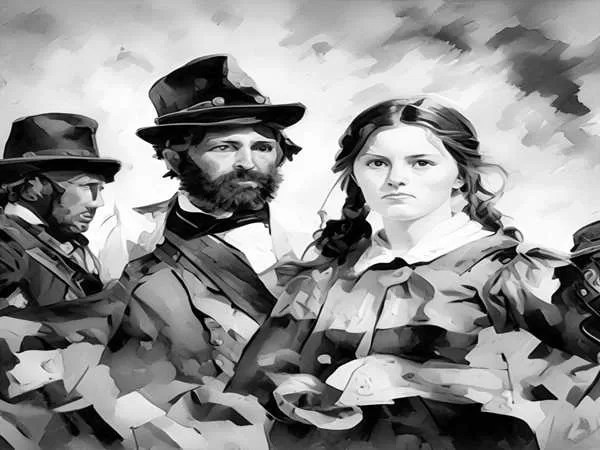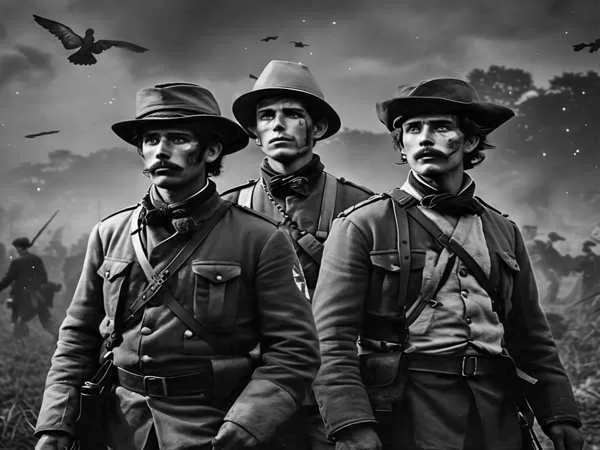The Battle of Gettysburg stands as a pivotal moment in American history, marked by bloodshed, heroism, and tragedy. This battle, fought from July 1 to July 3, 1863, in Gettysburg, Pennsylvania, became the turning point of the Civil War, with over 53,000 casualties. It was a battle that left a lasting legacy on the landscape, the nation, and even in the mysterious ghostly lore surrounding the battlefield.
A Chance Encounter Leads to One of History’s Bloodiest Battles
By July of 1863, the Civil War had raged for two long and brutal years. Neither side had gained a definitive upper hand, but the Confederate Army, led by General Robert E. Lee, was emboldened after victories in Virginia. Lee pushed north into Union territory, seeking a decisive victory that could force a peace agreement or European recognition of the Confederacy. However, fate intervened when Union and Confederate forces met by accident at Gettysburg.
This three-day engagement broke the Confederates’ momentum. The defeat at Gettysburg forced Lee’s army into retreat, and for the next two years until the war’s end, the Confederates found themselves on the defensive. Gettysburg did not just mark a military loss for the South; it was the battle that effectively broke the Confederacy’s back.
The Fight for Little Round Top: Joshua Lawrence Chamberlain’s Defining Moment
One of the most notable moments of the battle occurred on the second day, July 2, when the Confederates attempted to seize Little Round Top—a key high ground that offered a strategic advantage. Union Colonel Joshua Lawrence Chamberlain, a former college professor from Maine, was tasked with defending this position with his 20th Maine Regiment. Facing wave after wave of Confederate attacks from the 15th Alabama Infantry, Chamberlain and his men were running out of ammunition and options.

Knowing that surrender or retreat would expose the entire Union flank, Chamberlain made a bold decision to charge the enemy with bayonets, despite the lack of ammunition. This daring maneuver succeeded, forcing the Confederates to retreat and capturing over 100 Confederate soldiers. Chamberlain’s actions that day earned him the Medal of Honor and a lasting place in American military history. After the war, he would go on to serve as the Governor of Maine and as the president of Bowdoin College.
The Battle at Devil’s Den: Confederate Sharpshooters and Union Struggles
Just south of Little Round Top, another fierce struggle unfolded at a rocky outcropping known as Devil’s Den. Here, Confederate forces from the Texas Brigade and the 3rd Alabama Regiment, led by Major General John Bell Hood, attempted to break through the Union lines. The Union III Corps, made up of soldiers primarily from Northeastern Virginia and commanded by Major General David B. Birney, was tasked with holding this position.
Devil’s Den soon became a deadly location, with Union soldiers being picked off by hidden Confederate sharpshooters. One sharpshooter, concealed among the massive boulders, gained near-legendary status for his ability to pin down Union artillery and pick off soldiers without detection. While some historians debate the details, it is widely accepted that the sniper created havoc for Union forces until he was eventually located and killed by a well-placed artillery shell.
Despite suffering heavy casualties and confusion after Hood was injured and Brigadier General Evander M. Law took command, the Confederates were unable to break through the Union lines. The Union forces ultimately stood their ground at Devil’s Den, contributing to the overall Union victory at Gettysburg.
The Fatal Decision: Pickett’s Charge
The third and final day of the battle saw one of the most infamous assaults in military history: Pickett’s Charge. General Robert E. Lee, determined to break the Union center, ordered 12,500 Confederate soldiers to march across open ground towards Cemetery Ridge, where Union forces awaited them behind fortified positions.
The result was devastating for the Confederates. As the soldiers advanced, they were met with relentless rifle and artillery fire from Union forces. The attack failed disastrously, resulting in immense Confederate losses and forcing Lee to retreat. This marked the end of the Confederacy’s campaign in the North and signaled a shift in the momentum of the war.
Haunted by the Past: Ghosts of Gettysburg
The Battle of Gettysburg left behind more than just a historic legacy—it left lingering spirits, according to many who have visited the battlefield. The area around Devil’s Den is reputed to be one of the most active locations for ghost sightings. Many explanations have been offered as to why the spirits of these soldiers remain bound to the battlefield.
The Civil War was a conflict that literally pitted brother against brother. Officers and soldiers who once fought side by side now found themselves on opposite sides of the battlefield. These deep personal connections may be one reason why so many spirits are believed to remain. One such story involves Confederate officer Captain Lewis “Lo” Armistead, who was mortally wounded during Pickett’s Charge. Armistead was reportedly aided by Union officer Captain Henry H. Bingham, a fellow Mason, even as he lay dying from his wounds. This act of brotherhood in the midst of war is one of the many haunting stories that echo through Gettysburg’s history.
Ghostly Encounters at Devil’s Den
The legends of Devil’s Den are particularly eerie. Visitors often report drained batteries in cameras and unexplained cold spots, leading many to believe that the spirits of the soldiers who died there are still present. Some have even claimed to see apparitions of Confederate soldiers moving through the rocks, as if reliving the battle over and over again.
The story of the Confederate sniper at Devil’s Den adds to the mystique of the area. Though the exact details are debated, the presence of snipers at Devil’s Den was a significant factor in the Union’s difficulties during the battle. The energy of this intense struggle may be why the spirits remain so active, especially in this particular location.
A Battle That Shaped a Nation
The Battle of Gettysburg was a defining moment in American history, marking a turning point in the Civil War. The bravery and sacrifice displayed by both Union and Confederate soldiers have made it one of the most studied and remembered battles of all time. Yet, beyond the historical significance, Gettysburg remains a place where the past seems to linger in the present. Whether it is the ghostly soldiers at Devil’s Den or the stories of comrades helping each other in their final moments, Gettysburg is more than just a battlefield—it is a testament to the human cost of war and a reminder of the spirits that still call it home.

